Time to get rid of your peep and pin sight
What is a Red Dot Sight?
A red dot sight uses a non-magnifying “red dot” as the means of aim. However, the red dot sight uses an LED reticle on the glass lens. This lens is then coated to only reflect red light. When you are looking in a red dot, only the person using the red dot sight can see the dot.

What is an Iron Sight?
A typical iron sight has a two system set up, posts in the front and notch in the rear. So, you have to line up that notch in the back between the posts.
Iron Sights = Peeps & Pin(s)
Just like an iron sight, the posts in the front are like a pin(s) and the notch in the rear is like a peep. Iron sights require three steps: the front sight, the back sight, and the target. Pins and peeps are using these same three-step processes: the peep, the pin(s), and the target. By having a red dot we are eliminating the three-step process and taking it down to two: dot and target.
The Popularity of the Red Dot and Why?
Faster Target Acquisition
With an iron sight, you need to line up the post through the notches. However, with a red dot, you simply center the dot. By having to focus on one aspect versus multiple aspects, it allows for quicker reactions because the brain does not need to run through a list of multiple steps to line up your target. You just put your point of aim on the target, or as we say it at Adjustable Red Dot (ARD), center the dot.
Having Both Eyes Open
Your brain uses both of your eyes to center and search your field of vision. Having both eyes open when looking through a sight is instinctive and will further benefit your acquisition. Many people who shoot with an iron sight use only one eye to center that post and notch set up. This limits our brain’s ability to properly receive all of the information. Shooting with both eyes open allows you to properly and accurately scan your field of vision to put your aim on the target. With shooting with one eye open, you are limiting your ability to see your total field of vision.
Low-Light Conditions
As soon as light is limited, the ability to use an iron sight can be completely lost. However, with a red dot sight, you can change the brightness and often even the reticle size. So not only is this extremely advantageous for low-light conditions, but those with aging eyes or poor eyesight. This will help you quickly and accurately place the red dot, no matter the conditions. Whether it is early in the morning, late at night, or bright during the day. The red dot can adjust for your conditions.
Red Dot Sights on Bows
As seen the red dot sight has numerous advantages to help a shooter to be the most accurate and consistent. These advantages directly translate into bow hunting. And that is what we do here at Adjustable Red Dot (ARD). We are taking a Red Dot Sight, like the Ultra Dot which is a competition pistol sight, and putting it on a bow. Not only are we putting it on a bow, we made it adjustable for yardage. Now, when you go out bow hunting or practice this off-season, you can increase your target acquisition, shoot instinctively with both eyes open, and increase your low-light conditions.
Have More Questions?
Send us an email at adjustablereddot@gmail.com
Or call Tim Zelenka at 616-283-5024 to learn more about the Adjustable Red Dot for your bow.
Want Some More Information on Red Dots Versus Iron Sights?
Below is a link to a video by Wise Men Company, they did a mini-experiment testing out red dot versus iron sights. I suggest you check this out if you want to physically see the grouping differences between red dot and iron sights.
https://www.youtube.com/watch?v=okKNVyMSdtU
Additional information:
https://cudaoptics.com/red-dot-vs-iron-sights-which-is-better/
https://www.aimpoint.com/academy/aimpoint-red-dot-reflex-sights
https://opticsmag.com/red-dot-vs-iron-sights/
